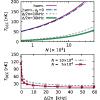当前位置:
X-MOL 学术
›
Phys. Rev. Lett.
›
论文详情
Our official English website, www.x-mol.net, welcomes your
feedback! (Note: you will need to create a separate account there.)
Quantum Bubbles in Microgravity.
Physical Review Letters ( IF 8.1 ) Pub Date : 2020-06-29 , DOI: 10.1103/physrevlett.125.010402 A Tononi 1 , F Cinti 2, 3, 4 , L Salasnich 1, 5
Physical Review Letters ( IF 8.1 ) Pub Date : 2020-06-29 , DOI: 10.1103/physrevlett.125.010402 A Tononi 1 , F Cinti 2, 3, 4 , L Salasnich 1, 5
Affiliation

|
The recent developments of microgravity experiments with ultracold atoms have produced a relevant boost in the study of shell-shaped ellipsoidal Bose-Einstein condensates. For realistic bubble-trap parameters, here we calculate the critical temperature of Bose-Einstein condensation, which, if compared to the one of the bare harmonic trap with the same frequencies, shows a strong reduction. We simulate the zero-temperature density distribution with the Gross-Pitaevskii equation, and we study the free expansion of the hollow condensate. While part of the atoms expands in the outward direction, the condensate self-interferes inside the bubble trap, filling the hole in experimentally observable times. For a mesoscopic number of particles in a strongly interacting regime, for which more refined approaches are needed, we employ quantum Monte Carlo simulations, proving that the nontrivial topology of a thin shell allows superfluidity. Our work constitutes a reliable benchmark for the forthcoming scientific investigations with bubble traps.
中文翻译:

微重力中的量子气泡。
超冷原子微重力实验的最新进展在壳形椭圆形玻色-爱因斯坦凝聚物的研究中产生了重要的推动作用。对于实际的气泡阱参数,这里我们计算了玻色-爱因斯坦凝聚的临界温度,如果与具有相同频率的裸谐波阱之一相比,则显示出很大的降低。我们用Gross-Pitaevskii方程模拟零温度密度分布,并研究中空冷凝水的自由膨胀。当部分原子向外扩展时,冷凝物会在气泡捕集器内部发生自干扰,并在实验可观察的时间内填充孔。对于处于强相互作用状态的介观数量的粒子,需要更精细的方法,我们使用量子蒙特卡洛模拟,证明了薄壳的非平凡拓扑允许超流动。我们的工作为即将进行的带有气泡阱的科学研究提供了可靠的基准。
更新日期:2020-06-29
中文翻译:

微重力中的量子气泡。
超冷原子微重力实验的最新进展在壳形椭圆形玻色-爱因斯坦凝聚物的研究中产生了重要的推动作用。对于实际的气泡阱参数,这里我们计算了玻色-爱因斯坦凝聚的临界温度,如果与具有相同频率的裸谐波阱之一相比,则显示出很大的降低。我们用Gross-Pitaevskii方程模拟零温度密度分布,并研究中空冷凝水的自由膨胀。当部分原子向外扩展时,冷凝物会在气泡捕集器内部发生自干扰,并在实验可观察的时间内填充孔。对于处于强相互作用状态的介观数量的粒子,需要更精细的方法,我们使用量子蒙特卡洛模拟,证明了薄壳的非平凡拓扑允许超流动。我们的工作为即将进行的带有气泡阱的科学研究提供了可靠的基准。











































 京公网安备 11010802027423号
京公网安备 11010802027423号